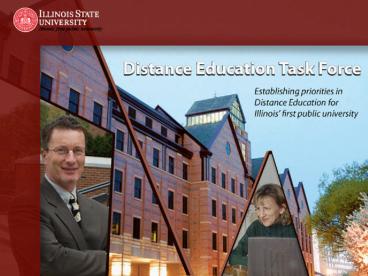A Definition of Distance Education PowerPoint PPT Presentation
1 / 46
Title: A Definition of Distance Education
1
(No Transcript)
2
A Definition of Distance Education
Distance education is a formal educational
process in which the majority of the learning
occurs when student and instructor are not in the
same location. Instruction may be synchronous or
asynchronous and may employ audio, video,
computer or other electronic technologies. This
would include for-credit and non-credit
activities for either individual courses/modules
or for entire programs. When conceptualized on a
continuum, distance education includes 100
face-to-face off-campus learning, web enhanced
learning, blended learning, and 100 online
learning.
3
Charge of the Taskforce
Charge The Distance Education Taskforce will
make recommendations that will support and extend
Illinois State Universitys high academic
standards through an integrated, planned, and
programmatic approach to distance education
consistent with Educating Illinois. The Taskforce
will identify both internal and external issues
that impact online education at Illinois State,
and make recommendations regarding distance
education that advance the core mission of the
university. Specifically the Taskforce is charged
with making recommendations to shape distance
education at ISU from 2009-2014.
4
Goals of the Taskforce
GOAL 1 CURRICULUM. The Taskforce will recommend
strategies to integrate distance education into
Illinois States overall academic plan. Such
strategic planning should include faculty
assessment of curricular programs at the
undergraduate and graduate levels to determine
the competencies, courses, and programs that
would be best learned through distance education.
5
Goals of the Taskforce
GOAL 2 INSTRUCTION. The Taskforce will
recommend the types and nature of initial and
on-going faculty professional development
necessary to prepare faculty for participation in
distance education at Illinois State University.
6
Goals of the Taskforce
- GOAL 3 POLICY. The Taskforce will recommend the
necessary institutional infrastructure at the
university, college, and unit level to support
the development, implementation, and maintenance
of high quality online courses and/or programs at
Illinois State University. Such recommendations
should include - intellectual property
- student academic honesty
- curricular review
- program review
- admission to fully online programs
- financial aid
- registration
- academic calendar and
- others as necessary
7
Goals of the Taskforce
GOAL 4 ADMINISTRATIVE STRUCTURE AND FUNDING.
The Taskforce will recommend administrative
structures and funding model(s) or necessary
resources to support distance education
curricular, programmatic, technological,
professional development, and delivery needs.
8
Timeline
Fall 2008 Semester September 4, 25 October
23 November 13 December 11 Spring 2009
Semester January 15 February 19 March 26 April
23 May 28 Summer 2009 Semester June 25
9
Background
10
Current State of Online Offerings at Illinois
State University 5 years of data
11
(No Transcript)
12
(No Transcript)
13
(No Transcript)
14
(No Transcript)
15
(No Transcript)
16
(No Transcript)
17
(No Transcript)
18
(No Transcript)
19
(No Transcript)
20
(No Transcript)
21
(No Transcript)
22
(No Transcript)
23
(No Transcript)
24
(No Transcript)
25
(No Transcript)
26
(No Transcript)
27
Summary State of Distance Education at Illinois
State University
- Growth in online enrollment and courses from 1
to 3 from 2004 to 2008 - Program Level Undergraduate more prevalent than
Graduate - In 2007 and 2008 summer outpaced the academic
year in online education courses and
enrollments - Resources We have seen a dramatic growth in
2007 and 2008 in online education courses
funded with non-GR money - By College Witnessed growth across the Colleges
since 2006 with variation amongst individual
Colleges
28
Summary State of Distance Education at Illinois
State University
- By Department
- 35 Departments
- 2004 26 (9) participated
- 2008 60 (21) participated
- When ISU is benchmarked (2005) nationally and
regionally, there is room for growth in terms
of online enrollments
29
Comments and Discussion
30
A National View of Distance Education The Sloan
Consortium
31
(No Transcript)
32
(No Transcript)
33
(No Transcript)
34
(No Transcript)
35
(No Transcript)
36
(No Transcript)
37
(No Transcript)
38
(No Transcript)
39
(No Transcript)
40
(No Transcript)
41
(No Transcript)
42
Summary The National View of Distance Education
- From 2002 to 2006 online enrollment nationally
- (a) Increased by 10 as a percentage of total
enrollment - (b) Is reaching a plateau
- 9.7 in 2006
- 36.5 in 2005
- At Institutions of 15,000 students Online
enrollments grew by 24 from 2004 to 2006 - At Masters granting institutions Online
enrollments grew by 20 from 2004 to 2006
43
Summary The National View of Distance Education
- Nationally Slight increase in percentage growth
of online programs between 2005 and 2006 - ISU is classified as engaged on a 5-fold
Online Learning Framework - 14.6 students took one online course at
engaged institutions - 45.6 of engaged institutions have fully
online programs - Why have online education?
- (a) Increase student access
- (b) Increase rate of degree completion
44
Summary The National View of Distance Education
- Chief Academic Officers say that online
education is strategically important for these
reasons - (a) Increase student access
- (b) Attract students from outside service area
- (c) Increase rate of degree completion
- Important Reducing or containing costs were
ranked lower - Barriers Chief Academic Officers identify
barriers to online education - (a) Students need more discipline to succeed
- (b) Lack of faculty acceptance
- (c) Development and delivery costs
45
Summary The National View of Distance Education
- Barriers At Institutions with 15,000 students
- (a) Greater faculty time and effort to teach
online courses - Quality of online education
- Nearly 75 Chief Academic Officers at public
universities rated online education equal to
or superior to face-to-face education
46
Comments and Discussion

